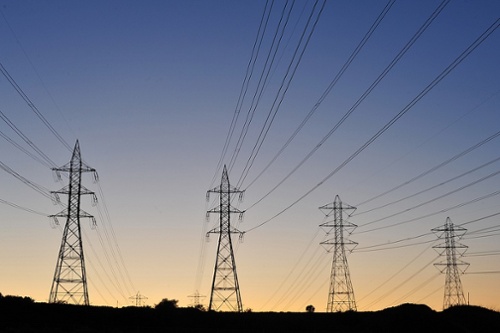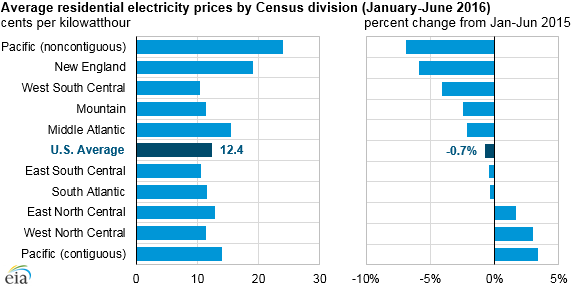Falling Electricity Rates, Bill Tracking, and Energy Efficiency

Like many energy geeks, I track my electricity usage and costs. I’ve been doing it for decades. (Unlike Danny Orlando, however, I haven’t stayed in the same house and watched as the home energy improvements kept lowering that usage.) One thing I’ve noticed in the past few months is that the electricity rate I pay to Georgia Power has dropped significantly. Yesterday, the US Energy Information Administration (EIA) confirmed that falling electricity rates is a (mostly) national trend.
Falling rates
Here’s a graph from the EIA article that shows the magnitude of the drop.
The announcement from the EIA may have been a surprise to some people but it wasn’t to me. Each month when my electricity bill arrives, I enter the new data into my spreadsheet. My main interest is in how my total bill and electricity consumption change over time. I also track the rates. Here’s what our rate has been doing this year.
We’ve been at 12 to 13 cents per kilowatt-hour for a while, but suddenly this summer it dropped to 10 cents per kWh. When the rate changes like that, it usually means the fuel costs paid by the utility are changing. The EIA report confirms that indeed, natural gas prices were lower in the first half of this year. Hence the reduction in rate.
The EIA report also predicts the price of natural gas will be higher for the rest of 2016 and in 2017 as well. So don’t get too comfortable with the lower rates.
Electricity rates, bills, and externalities
In general, I’m not a fan of low rates. I am a fan of low bills, though, since that’s what I actually have to pay. Utilities used to make a lot of their decisions based on what they called the Rate Impact Measure (RIM) test. It was a horrible way to decide whether to build new plants or adopt demand side management plans. The latter would almost always lose out to the former because utilities have lots of subsidies and access to cheap capital.
But even low bills create problems. We’ve gotten a lot better than we were a few decades ago, but our electricity in the US is still pretty dirty. With low electricity bills, there’s just not a lot of incentive to improve.
The reason for this is that a lot of the problems get paid for by someone else:
- The millions of kids sucking on inhalers because they can’t breathe
- Taxpayers who cover the subsidies
- Building owners who have to repair buildings damaged by air pollution
These external costs often get passed on to others, which is great for electricity rates and bills, not so good for the environment and other parts of the economy.
So, don’t let the lower rates stop you from reducing energy use. And with winter approaching, this is a good time to do something. (Just don’t follow the conventional advice.)
Related Articles
Electricity Demand and the Duck Curve
Would You Rather Have Low Energy Rates or Low Energy Bills?
How Dirty Is Your State’s Electricity?
Photo of power lines by Chris Hunkeler from flickr.com, used under a Creative Commons license.
NOTE: Comments are moderated. Your comment will not appear below until approved.
This Post Has 6 Comments
Comments are closed.


I’m pleased you made the
I’m pleased you made the distinction between low rates and low bills.
Last evening I attended a forum sponsored by Bring Back Solar, an organization working to change the national embarrassment of Nevada’s PUC first dramatically raising costs for owners of rooftop solar, then, under heavy consumer and political pressure, grandfathering in 32,000 rooftop customers at the original rate. In December of 2015, rooftop solar owners saw their payback periods extend to 20+ years 😱.
Installation companies fled the state, talking thousands of jobs (thanks, Warren Buffet, owner of the parent company of NV Energy) and installation permit requests dropped dramatically. Why they did not go to zero is a puzzlement.
Two of the 3 PUC members are new in the last week and the organization is starting with a clean sheet to resolve the “rooftop solar is good/bad for all rate payers” conundrum. Conflicting reports from recent years (ignoring externalities) have been contradictory.
Where was I?
NV Energy continues to taut falling costs/kWh while basic connection charges have crept upward.
Film at 11 as this situation plays out in probably the sunniest state in the Republic.
Really nicely put together
Really nicely put together Allison.
It is going to be a disruptive time. Utilities that don’t actively put their client interests first. They’ll need to be explicit about it.
Utilities like the one in Nevada may find themselves in the water next to lifeboats occupied by folks who are entertained by watching them drown rather than concerned about pulling them to safety.
Building client loyalty and trust is the key to success in the 21st century. Look at Amazon, their success is focusing on the customer experience and building trust…
Allison, I also like that you
Allison, I also like that you are opening the discussion about unpriced externalities.
Privatize profits and socialize costs – when Capitalism begins feeding on itself. Private companies polluting the air for free are profiting from unpriced externalities of their harm that then become a socialized cost. It creates in balance in intersection of the supply and demand curves, unfair advantage.
Will you do an article on the attempts to fix Economic perversities by groups like Citizens Climate Lobby, and about how a revenue neutral border adjustable Carbon Fee and Dividend would be great for Energy Efficiency, Environment, and the Economy through progressive redistribution?
That’ll be a challenging one to write.
Yes Steve, rates and bills
Yes Steve, rates and bills are two different perspectives. For another perspective:
When it comes to energy costs, history shows that what goes down will go back up. The EIA rightfully notes that “temporarily” low NG prices are already on the rebound. Wait until more stringent controls are placed on NG production and distribution, more utilities covert from coal to NG, trucking fleets begin using more CNG, and any exporting of NG takes place.
I have been continually astounded that when gasoline prices drop, big SUV sales go up. What person with any common sense would expect low gas prices not to go back up over the ownership period of a motor vehicle? But lets get back to home energy use.
So, national electric prices have fallen 0.7%, which means my average monthly electric bill ~$100-125 will go down about $1.00 – – not even enough to upgrade a Starbuck’s beverage. Of course, if I had a $400 monthly electric bill, I would be saving almost $3.00 – – barely enough to buy a fancy Starbuck’s drink. Sorry for the cynacism, but WOW!
OTOH: A new Super Energy Efficient home can easily use at least 75% less energy for heating and cooling than a new home built to minimum codes. They usually cost 10% more to build, but they can cut a $400 energy bill to $100. A $300 dollar a month saving can very easily cover the additional 10% financing costs – – on average saving you almost a non-taxable $200 per month. Energy prices ever double and you will have an additional $600 in your wallet over your neighbor with what was a new minimum code home. Existing homes can also achieve similar energy savings, but at somewhat higher financing costs, but along with more equity in the homes.
Home and building owners need to be educated on these issues.
“What’s in your wallet?” $200+ more per month with a more comfortable home to return to or ….
BTW: The power companies that continue to fight the inevitable future, as is being done in NV, will eventually be the big losers. They need to be educated as to how to change their business models and take advantage of the future.
The changing landscape for
The changing landscape for electrical generation combined with renewables and efficiency efforts makes for a challenging future. New York State is taking a different tack on how distribution grid operations will work in NY’s Reforming the Energy Vision (REV) future. Rocky Mountain Institute summerizes it here, with a link to the original report. http://blog.rmi.org/blog_2015_08_27_new_york_REV_distributed_platform_breaks_new_ground
Actually under a true
Actually under a true capitalistic society where property rights are defended it’s more likely that highly polluting industries would no longer be able to operate at a profit. Pollution would after all be considered an “aggression” against neighboring property owners.
Remember the current regulatory scheme allows just enough pollution that won’t kill everyone but just a few.